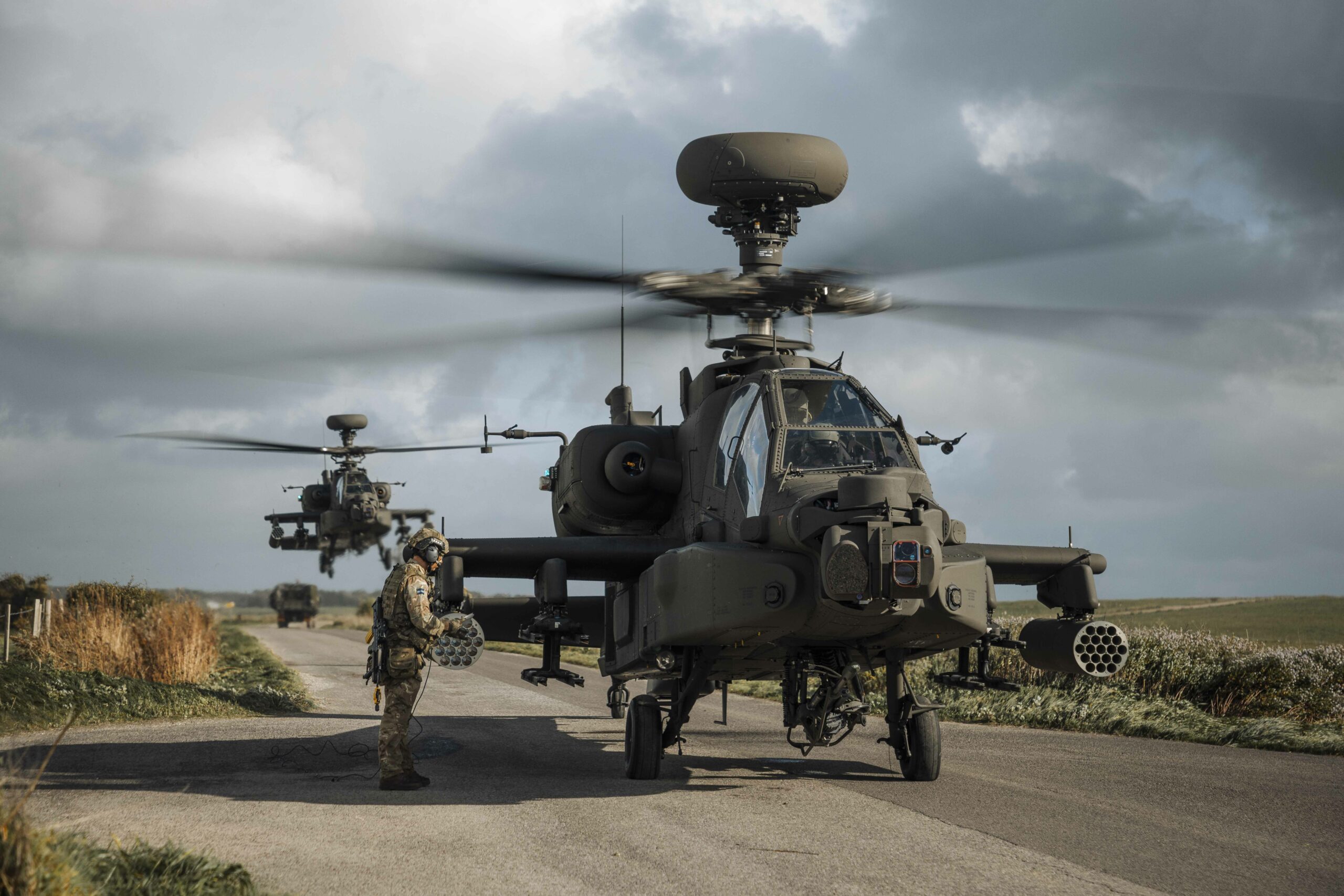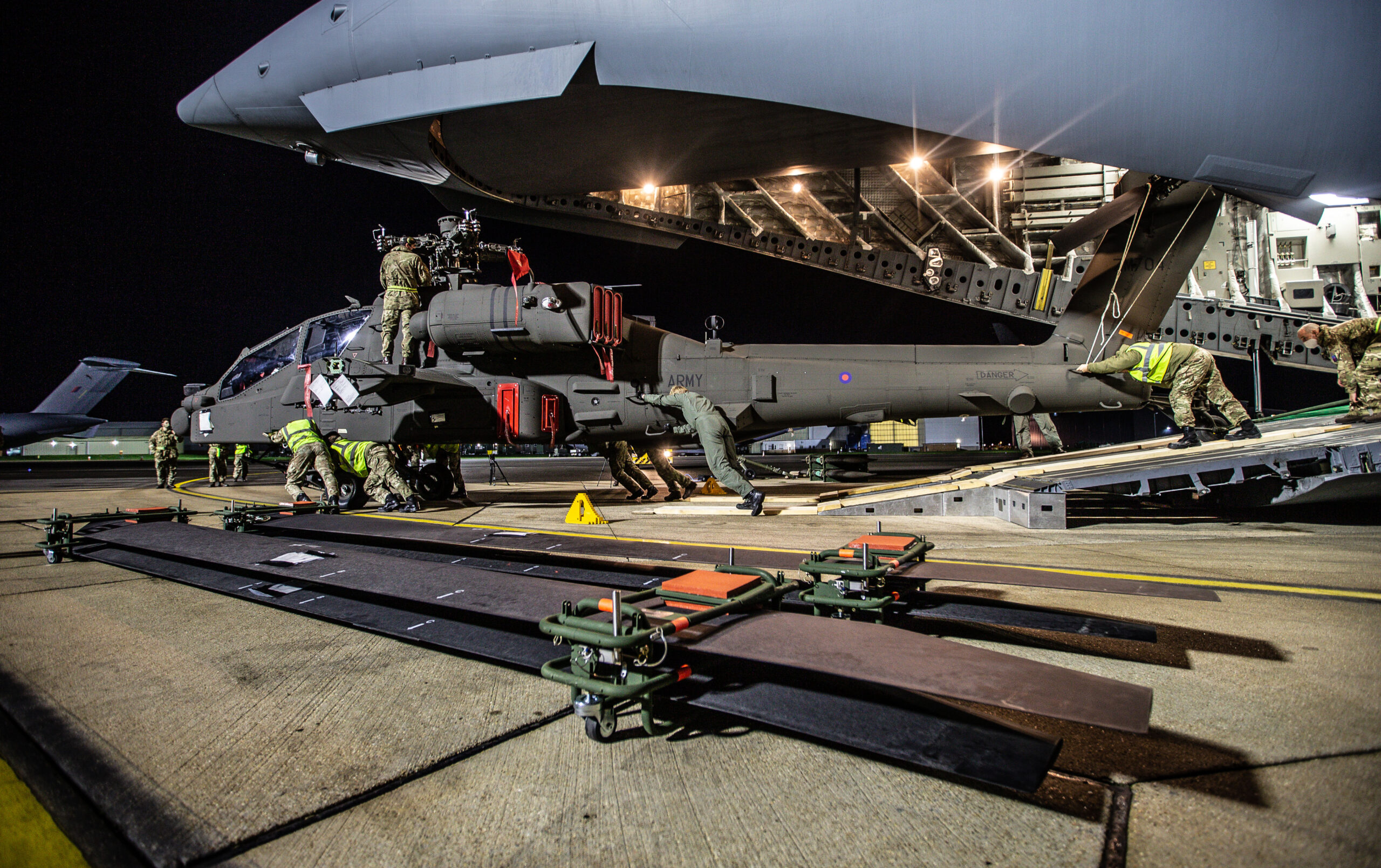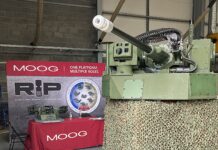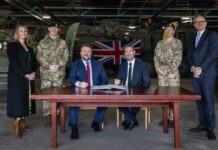With the first two new aircraft having entered service with the UK’s Army Air Corps (AAC) 18 months ago, further deliveries of these latest helicopters are set to take the British Army Apache-64E fleet to 50 in the not-too-distant future.
Described as more lethal, agile and survivable than previous versions of the aircraft, the British Army’s new Apache AH-64Es have been steadily filling the hangars of the UK’s AAC since 2022 and taking to the skies of the southern and eastern counties of the UK under the British Army’s Apache Capability Sustainment Programme (CSP). This article looks at how the programme has unfolded, together with latest developments.

Credit: UK MoD
Setting the Apache CSP Scene
In the UK’s Strategic Defence and Security Review 2015, the need to maintain an effective attack helicopter capability was reaffirmed and a holistic approach was set in motion to address what was needed from both the platform itself – the Apache – as well as such needs as the ‘strategic interoperability’ such an asset would need to offer to allies.
The British Army’s Head of Capability for Air Manoeuvre was appointed as the programme’s Senior Responsible Owner (SRO) to oversee the Apache CSP, in turn being personally accountable to the Chief of the General Staff (CGS) for delivering the programme.
Additionally, within the Defence Equipment & Support (DE&S) unit of the MoD, its Apache Project Team was made responsible for procurement of the aircraft together with support solutions. Once this structure was in place, the Army undertook a cost/benefit analysis of the requirement to eliminate any unnecessary UK-specific ‘wants’ that might have incurred additional costs and increased delivery times, without adding to the attack helicopter capability in any significant way. As a result, it was decided to acquire the new AH-64E, in an off-the-shelf arrangement, with only two changes from the baseline US Army design – a UK Defensive Aids System in order to maintain operational sovereignty, and a windscreen wash-wipe capability to enable maritime operations.
This off-the-shelf procurement approach not only met all Army requirements, but also enabled the UK to benefit from through-life burden-sharing and the enhanced interoperability with key allies, such as the US, determined as essential in early consideration of the requirement. This approach was fully approved by the MoD in 2016 and it was agreed that 50 new Apache AH-64E helicopters would be acquired, to be built by Boeing via a foreign military sales arrangement worth USD 2.3 Bn through the US Government. The new aircraft would address existing, as well as predicted obsolescence issues that were set to impact operational capabilities of the UK Apache AH Mk1 fleet from that time onwards. But it is the new technologies incorporated into the AH-64E that convinced stakeholders this was the right aircraft and way forward to provide the UK with the advanced operational capabilities its attack helicopters needed to be fit for the battlefields of tomorrow.
The Apache CSP is now at the forefront of British Army programmes and its whole approach is likely to be followed by other capability change programmes; the Chinook CSP currently underway, is one example where this is happening. In terms of strategic benefits, the MoD’s defence relationship with the US has been at the heart of the programme. Both interoperability and influence are key tenets of the CSP and a co-operative working arrangement has secured influence on aspects of the US aircraft design, as well as future US Army requirements, including the co-development of a real-time operating system that enables off-the-shelf solutions that better meet a UK requirement.

Credit: UK MoD
Programme Underway
It was agreed that the best long-term solution was to adopt the current US Army standard of Apache AH-64E Guardian v6 for a number of reasons, which included being supported by the manufacturer for a longer time. Building an AH-64E has actually been achieved in the US via two tracks: new-build airframes; or the refurbishment and upgrade of existing airframes, with the route chosen depending on the age and current standard of the existing airframe. In making its decision as to which track to adopt, the UK sent a single airframe to Boeing at Mesa, Arizona to understand if the upgrade/refurbish route was feasible. This proved not to be the case, so it was decided to go for brand new AH-64E airframes as the most cost-effective option, through re-using [and] incorporating as many existing, relevant Apache AH1 components and equipment items as possible.
Having made this choice, old UK Apache AH1s were then selected for the CSP and shipped to the US, based on airframe. For example, in February 2018, airframes ZJ166 and ZJ167 were shipped followed by ZJ182 and ZJ188 in July 2022. Some UK systems and components were removed at Wattisham Airfield in Suffolk, (home to 3 Regiment and 4 Regiment of the Army Air Corps), before being sent to Science and Engineering Solutions (SES) at Huntsville, Alabama, where further stripping of the airframe of remaining, useable components was done. The empty airframe hulks themselves were then discarded. The useable components have then been sent to Boeing at Mesa for integration with the new AH-64Es during the course of the programme. As for the brand-new AH-64E airframes, these have been built on the production line in India, then shipped to Arizona for fitting out and systems integration, including the installation of previously recovered AH1 components. Once test flown, they are then air-freighted to the UK for delivery to the AAC, with the programme proceeding at a rate of roughly one Apache per month.
First Deliveries
According to schedule, and under the watchful eye of the MoD team instrumental to delivering the programme, led by DE&S Boeing helicopters portfolio manager, Air Commodore Owen Barnes, the first two new Apache AH-64E Version 6 attack helicopters were delivered to the British Army at Wattisham Airfield at the end of November 2020. The aircraft were accompanied by aviation technicians from 7 Aviation Support Battalion, Royal Electrical and Mechanical Engineers (7 Avn Spt Bn REME), to maintain and service the new aircraft. The eventual fleet of 50 AH-64E Version 6 aircraft will fully replace the Apache AH Mk1, which reaches its out-of-service date in 2024, when deliveries of the new aircraft are slated for completion by mid-summer of that year.

Credit: UK MoD
First UK test flying of the new aircraft commenced in July 2021 and initially focused on trials activity and developing instructional techniques to safely manage aircrew transition from Mark 1 to the E-model. The focus then changed to the full-rate conversion training of 3 Regiment Army Air Corps (3 Regt AAC). Before flying began, however, the full air system safety issues were tested to ensure safe flying was fully supported. This included quality assurance and airworthiness tasks by the REME ground crews, together with certification by the UK Military Aviation Authority, assurance of aircraft documentation, simulators, training and instructors. The new engines, drivetrain, main rotor blades and avionics deliver a significant boost in aircraft performance and embedded system-level diagnostics deliver increased aircraft availability. The aircraft has an extended-range fire control radar, including a maritime mode that ensures the aircraft can operate in the maritime environment. In addition, Link 16, Mode 5 IFF and manned-unmanned teaming (MUM-T) provide theatre entry-standard equipment fits and vastly increase crew battle-space awareness. All these new systems and features have pushed the learning envelope for air and ground crews to their highest levels.
At the time of the first deliveries, Brigadier Steve Hussey, Head of Capability Air Manoeuvre, said in a statement that while there was still some way to go before the Army’s modernised attack helicopter capability reached its full operational status, the arrival of the first Apache E Model in the UK was a major programme milestone. His colleague and Commander 1 Aviation Brigade, Brigadier Paul Tedman CBE, added that the AH-64Es would eventually team with Wildcat helicopters to ”provide the backbone of the UK Aviation Brigade’s capabilities” as it grows towards its own full operating capability in 2023.
Adding to those voices on the occasion of that first delivery, Maj. Gen. Jez Bennett, Director Capability, said that the arrival of the new aircraft marked the beginning of a significant uplift in capability to enhance the Army’s contribution across the spectrum of military operations, from supporting hostage rescue missions, to countering an adversary’s anti-access, area denial platforms. He added that the new variant “outstrips” the outgoing Mark 1 aircraft by increased platform digitalisation, improved weapons and avionics, and the ability to use the latest and future technology to enable teaming with semi-autonomous systems, such as UAVs.
Long-term Support
In January 2022, by which time 14 of the eventual 50 new-variant aircraft were already in the UK, the MoD’s DE&S signed a Long-Term Training and Support Services (LTTSS) deal with Boeing Defence UK, under which Boeing now provides long-term training, support and sustainment for the new fleet. Valued at GBP 287 M, the LTTSS contract, announced at that time by UK Minister for Defence Procurement, Jeremy Quin MP, during a visit to Wattisham Airfield, sees Boeing working closely with the British Army at Wattisham to provide maintenance and engineering support, supply chain and logistics management. The company is also providing aircrew and maintainer training under the contract from its advanced facility at the Army Aviation Centre/Army Air Corps HQ at Middle Wallop in Wiltshire. [As of July 2022, the Army Aviation HQ at Middle Wallop, also began operating the AH-64E. BWhilst Wattisham Airfield is home to the new frontline AH-64E regiments, the new Apaches stationed at Middle Wallop are now operating with 7 Regiment AAC as the instructional platforms on which pilots and gunners will train.]

Credit: UK MoD
The LTTSS agreement is set to run until 2040 and has created more than 200 jobs in the UK, which will be active during its first four-years, including more than 165 at Middle Wallop, as well as 45 at Wattisham; dozens of related jobs are also ongoing with suppliers in the UK. (Boeing already had more than 40 employees working alongside AAC personnel providing training for the Mk1 Apache).
In addition to the new Boeing roles, the training and support for the new Apache model established new roles and opportunities for Boeing’s UK supply chain; Yeovil-based Kuehne & Nagel are providing a warehouse management service at Wattisham with a dispersed store at Middle Wallop, creating 45 new jobs. Meanwhile, H&S Aviation is undertaking repair and overhaul of engines in Portsmouth, subcontracted to GE Aviation, and Cheltenham-based Pennant is providing additional simulated training systems to Boeing as part of the deal, delivering several new and upgraded part task trainers with E-model compatibility, sustaining around 50 skilled jobs.
Jeremy Quin was accompanied at Wattisham by Deputy Chief of the General Staff, Lieutenant General Sir Chris Tickell KBE, and together they met pilots from 3 Regt AAC, plus engineers and groundcrew. The regiment, part of 1st Aviation Brigade Combat Team, is the first UK unit to field the AH-64E, with engineers and aircrew undertaking training courses in the USA as part of the CSP. Throughout the programme, as aircraft have arrived from the US into the unit’s hangars at Wattisham, ground crew have made all necessary checks on aircraft delivered. Latest features they’ve been familiarising themselves with include the aircraft’s new drivetrain and rotor blades which boost flying performance, its improved sights and sensors, new communications systems to share data with other helicopters, UAVs and ground forces, as well as embedded maintenance-diagnostic systems to increase aircraft availability.
Simulation, Flying, Performance
In addition, three Longbow Crew Trainers are now in operation with frontline AAC Apache squadrons, playing a key role transitioning the crews to the new variant. The Longbow Crew Trainer is the centrepiece of Boeing’s AH-64 Apache training. The high-fidelity flight simulator is used by pilots and other personnel to practice aircraft procedures and rehearse missions. It is containerised and deployable, allowing in-theatre training under a wide range of conditions.

Credit: Tim Guest
While test flights have been ongoing since July 2021, initial operating capability was achieved in early 2023. The aircraft has a top speed of 300 km/h (186 mph) and with new avionics and sensor suite can detect 256 potential targets at once, prioritising the most urgent threats within seconds, up to a range of 16 km (10 miles). The AH-64E is faster than the Mk 1 and can climb quicker thanks to new composite rotors designed to be more resistant than their predecessors to hits from ground fire; they also allow it to carry a heavier payload of weaponry and thus increase its lethality. Those weapons have their targets acquired and weapons guided by a vastly improved radar and sighting systems’ suite, new to the crews. The aircraft also includes an advanced target prioritising system, which helps with rapid reassessment and survivability in countering enemy threats. The UK’s Defence Science and Technology Laboratory (Dstl) evaluated the safety of the AH-64E’s software and human-machine interface, contributing to the aircraft’s release to service in 2022. That said, it did identify potential risks to aircrew as they converted to flying the new helicopter, underlining the need for exhaustive flight training, including on simulators.
Testing Exercise
The new Apache AH-64E made its first full deployment into the field during Exercise Talon Guardian, in October 2022, which saw 3 Regt AAC take a 1,500 km road trip over two weeks, establishing itself at three separate locations to plan and execute attack missions and maintain these state-of-the-art helicopters. The regiment’s commanding officer, Lieutenant Colonel Simon Wilsey, said in a statement that the exercise was a “significant step forward” for the new aircraft, with the regiment working hard to learn how to fly and maintain the AH-64E in the field, tackling the additional complexities of living, planning, maintaining and operating in austere environments. He said that with its “vastly improved capabilities”, it was not a case of going back to what was done before, but starting to use all the new systems and capabilities, including in the context of lessons from current conflicts, and adapting to ensure relevance and survivability.

Credit: UK MoD
The exercise was about basic field craft in the air, as well as on the ground, including dispersing and camouflaging positions to prevent observation by drones, and communicating by data over long range. For aircrew, honing flying skills using natural cover, as well as familiarisation with all aircraft sensors to counter air defence systems and low-tech threats were also part of the deployment. The overall aim was to prepare 3 Regt AAC for its core role, providing an aviation deep attack battlegroup as part of 1st Aviation Brigade Combat Team, to the British Army’s warfighting division, 3rd (United Kingdom) Division. During the course of the exercise, aircrew hunted for artillery and armoured vehicles on Otterburn Ranges in Northumberland and for Challenger 2 tanks protected by air defence systems on Salisbury Plain, Wiltshire. One pilot said at the time, that although the exterior looked the same, everything on the inside had changed to deliver improved capabilities in sensors, flying performance, weaponry and communications, and that the switch to the AH-64E from the Apache Mk1 was like changing mobile phones from a Nokia 3310 to an iPhone 14!
Up-to-Date
With the programme proceeding at a rate of roughly one Apache per month, over 30 aircraft are now with the AAC in the UK and the full fleet number of 50 aircraft, (down from the original 67 Apache AH1s), is due to be achieved during 2024, which is comfortably on target.
So far in 2023, three new aircraft – ZM728, ZM729 and ZM730 – arrived in March, airfreighted from Arizona to RAF Mildenhall in the UK aboard a USAF C-5M Galaxy, then readied for a road move by REME crews and moved to Wattisham by the UK’s Joint Aircraft Recovery and Transportation Squadron (JARTS).

Credit: UK MoD
Other aircraft, AH-64E ZM725, and ZM723, made short test flights at Wattisham in March, following re-assembly after delivery by air freight from the manufacturer. April saw AH-64E ZM727 take to the air for the first time at Wattisham, as ‘ArmyAir607’. Then, in June, AH-64E ZM726 ‘Outlaw1’ test flew from the air station, followed on 29 June by 4 Regt AAC’s 664 Sqn taking to the skies over Suffolk in AH-64E ZM709.
Tim Guest






![Serve to lead Serve to lead. Officer Cadets march past the Old College building during their commissioning ceremony, known as Sovereign’s Parade. [Crown Copyright 2013]](https://euro-sd.com/wp-content/uploads/2025/09/S1-Kopie-218x150.jpg)







